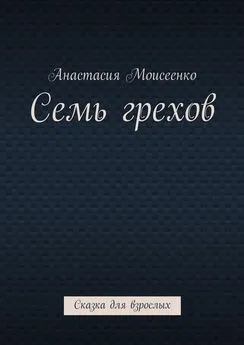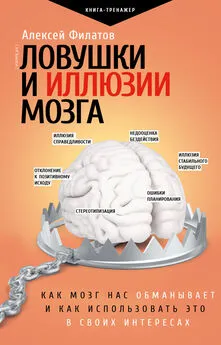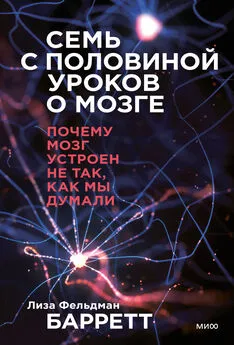Дэниел Шектер - Семь грехов памяти. Как наш мозг нас обманывает
- Название:Семь грехов памяти. Как наш мозг нас обманывает
- Автор:
- Жанр:
- Издательство:Литагент Аттикус
- Год:2021
- Город:Москва
- ISBN:978-5-389-19530-1
- Рейтинг:
- Избранное:Добавить в избранное
-
Отзывы:
-
Ваша оценка:
Дэниел Шектер - Семь грехов памяти. Как наш мозг нас обманывает краткое содержание
«Выдающийся гарвардский психолог Дэниел Шектер изучает ошибки памяти и разделяет их на семь категорий… Новаторское научное исследование, дающее представление об удивительной неврологии памяти и содержащее ключ к общему пониманию сбоев в работе мозга». (USA Today) В формате PDF A4 сохранен издательский макет.
Семь грехов памяти. Как наш мозг нас обманывает - читать онлайн бесплатно ознакомительный отрывок
Интервал:
Закладка:
Halperin J. L . The truth machine. Dallas: Ivy Press, 1996.
Hanley J. R., Cowell E. S . The effects of different types of retrieval cues on the recall of names of famous faces // Memory and Cognition. 1988. Vol. 16. P. 545–555.
Hanley J. R. Are names difficult to recall because they are unique? A case study of a patient with anomia // The Quarterly Journal of Experimental Psychology. 1995. Vol. 48A. P. 487–506.
Hanley J. R., Kay J . Proper name anomia and anomia for the names of people: Functionally dissociable impairments? // Cortex. 1998. Vol. 34. P. 155–158.
Happe F . Autism: Cognitive deficit or cognitive style? // Trends in Cognitive Sciences. 1999. Vol. 3. P. 216–222.
Harley T. A., Brown H. E . What causes the tip-of-the-tongue state? Evidence for lexical neighborhood effects in speech production // British Journal of Psychology. 1998. Vol. 89. P. 151–174.
Hastie R., Schkade D. A., Payne J. W . Juror judgments in civil cases: Hindsight effects on judgments of liability for punitive damages // Law and Human Behavior. 1999. Vol. 23. P. 597–614.
Hauser M. D . Wild minds: What animals really think. N. Y.: Henry Holt, 2000.
Hawkins S. A., Hastie R . Hindsight: Biased judgments of past events after the outcomes are known // Psychological Bulletin. 1990. Vol. 107. P. 311–327.
Hay D. C., Young A. W., Ellis A. W . Routes through the face recognition system // Quarterly Journal of Experimental Psychology. 1991. Vol. 43A. P. 761–791.
Heine S. J., Lehman D. R., Markus H. R., Kitayama S . Is there a universal need for positive self-regard? // Psychological Review. 1999. Vol. 106. P. 766–794.
Henke K., Weber B., Kneifel S., Wieser H. G., Buck A . Human hippocampus associates information in memory // Proceedings of the National Academy of Sciences of the United States of America. 1999. Vol. 96. P. 5884–5889.
Henkel L. A., Johnson M. K., DeLeonardis D. M . Aging and source monitoring: Cognitive processes and neuropsychological correlates // Journal of Experimental Psychology: General. 1998. Vol. 127. P. 251–268.
Henson R. N. A., Rugg M. D., Shallice T. et al . Recollection and familiarity in recognition memory: An event-related functional magnetic resonance imaging study // Journal of Neuroscience. 1999. Vol. 19. P. 3962–3972.
Heuer F., Reisberg D . Emotion, arousal, and memory for detail // The handbook of emotion and memory: Research and theory / Ed. by S.-A. Christianson. Hillsdale, N. J.: Erlbaum Associates, 1992. P. 151–180.
Hicks V. L . Experts explain John Doe 2 «sightings»: Bombing suspect may have been figment of witnesses’ imaginations // Boston Globe. 1998. June 14. P. A14.
Higham P. A . Believing details known to have been suggested // British Journal of Psychology. 1998. Vol. 89. P. 265–283.
Hilts P . Memory’s ghost: The strange tale of Mr. M and the nature of memory. N. Y.: Simon and Schuster, 1995.
Hilts P . J. In research scans, telltale signs sort false memories from true // New York Times. 1996. July 2. P. C 3.
Hinkle L. E., Wolff H. G . Communist interrogation and indoctrination of «enemies of the states» // Archives of Neurology and Psychiatry. 1956. Vol. 76. P. 115–174.
Holman E. A., Silver R. C. Getting «stuck» in the past: Temporal orientation and coping with trauma // Journal of Personality and Social Psychology. 1998. Vol. 74. P. 1146–1163.
Holmberg D., Homes J. G. Reconstruction of relationship memories: A mental models approach // Autobiographical memory and the validity of retrospective reports / Ed. by N. Schwarz, S. Sudman. N. Y.: Springer-Verlag, 1994. P. 267–288.
Houle D . Review of A. P. Møller and J. P. Swaddle: Asymmetry, developmental stability and evolution (1997) // Evolution. 1998. Vol. 52. P. 1872–1876.
Huppert F. A., Kopelman M. D . Rates of forgetting in normal ageing: A comparison with dementia // Neuropsychologia. 1989. Vol. 27. P. 849–860.
Hyman I. E., Husband T. H., Billings F. J . False memories of childhood experiences // Applied Cognitive Psychology. 1995. Vol. 9. P. 181–197.
Hyman I. E. Jr., Pentland J . The role of mental imagery in the creation of false childhood memories // Journal of Memory and Language. 1996. Vol. 35. P. 101–117.
Hyman I. E., Billings F. J. Individual differences and the creation of false childhood memories // Memory. 1998. Vol. 6. P. 1–20.
Jack C. R., Petersen R. С., Xu Y., et al . Rate of medial temporal lobe atrophy in typical aging and Alzheimer’s disease // Neurology. 1998. Vol. 51. P. 993–999.
Jack D . Between the lines of writer’s fall from literary pinnacle // The Scotsman. 1998. July 11. P. 3.
Jacoby L. L., Kelley C. M., Brown J., Jasechko J . Becoming famous overnight: Limits on the ability to avoid unconscious influences of the past // Journal of Personality and Social Psychology. 1989a. Vol. 56. P. 326–338.
Jacoby L. L, Kelley C. M., Dywan J . Memory attributions // Varieties of memory and consciousness: Essays in honour of Endel Tulving / Eds. H. L. Roediger III and F. I. M. Craik. Hillsdale, N. J.: Erlbaum Associates, 1989b. P. 391–422.
Jacoby L. L. A process dissociation framework: Separating automatic from intentional uses of memory // Journal of Memory and Language. 1991. Vol. 30. P. 513–541.
Jacoby L. L . Ironic effects of repetition: Measuring age-related differences in memory // Journal of Experimental Psychology: Learning, Memory, and Cognition. 1999. Vol. 25. P. 3–22.
James T. W., Kimura D . Sex differences in remembering the locations of objects in an array: Location-shifts versus locations-exchanges // Evolution and Human Behavior. 1997. Vol. 18. P. 155–163.
Jennings J. M., Jacoby L. L . Automatic versus intentional uses of memory: Aging, attention, and control // Psychology and Aging. 1993. Vol. 8. P. 283–293.
Johnson M. K., Chalfonte B. L . Binding of complex memories: The role of reactivation and the hippocampus // Memory systems / Eds. D. L. Schacter and E. Tulving. Cambridge, Mass.: MIT Press, 1994. P. 311–350.
Johnson M. K., Nolde S. F., Mather M. et al . The similarity of brain activity associated with true and false recognition memory depends on test format // Psychological Science. 1997. Vol. 8. P. 250–257.
Jones G. V., Langford S . Phonological blocking and the tip of the tongue state // Cognition. 1987. Vol. 26. P. 115–122.
Jones G. V . Back to Woodworth: Role of interlopers in the tip-of-the-tongue phenomenon // Memory and Cognition. 1989. Vol. 17. P. 69–76.
Kanowski S., Hermann W. M., Stephan K. et al . Proof of efficacy of the Ginkgo biloba special extract EGb 761 in outpatients suffering from mild to moderate primary degenerative dementia of the Alzheimer type or multi-infarct dementia // Pharmacopsychiatry. 1996. Vol. 29. P. 47–56.
Kanwisher N., McDermott J., Chun M. M. The fusiform face area: A module in human extrastriate cortex specialized for face perception // Journal of Neuroscience. 1997. Vol. 17. P. 4302–4311.
Kapur N. Syndromes of retrograde amnesia: A conceptual and empirical synthesis // Psychological Bulletin. 1999. Vol. 125. P. 800–825.
Karney B. R., Coombs R. H . Memory bias in long-term close relationships: Consistency or improvement? // Personality and Social Psychology Bulletin. In press.
Kassin S. M., Wrightsman L. S . Coerced confessions, judicial instruction, and mock juror verdicts // Journal of Applied Social Psychology. 1981. Vol. 11. P. 489–506.
Kassin S. M., Kiechel K. L . The social psychology of false confessions: Compliance, internalization, and confabulation // Psychological Science. 1996. Vol. 7. P. 125–128.
Kawabata Y . Yumiura, First snow on Fuji. Washington, D. C.: Counterpoint, 1999. P. 187–199.
Keane T. M., Fairbank J. A., Caddell J. M., Zimering R. T . Implosive (flooding) therapy reduces symptoms of PTSD in Vietnam combat veterans // Behavior Therapy. 1989. Vol. 20. P. 245–260.
Kebbell M. R., Wagstaff G. F . Hypnotic interviewing: The best way to interview eyewitnesses? // Behavioral Sciences and the Law. 1998. Vol. 16. P. 115–129.
Kebbell M. R., Milne R., Wagstaff G. F. The cognitive interview: A survey of its forensic effectiveness // Psychology, Crime and Law. 1999. Vol. 5. P. 101–115.
Keuler D. J., Safer M. A . Memory bias in the assessment and recall of pre-exam anxiety: How anxious was I? // Applied Cognitive Psychology. 1998. Vol. 12. S 127–137.
Kihlstrom J. F . The trauma-memory argument // Consciousness and Cognition. 1995. Vol. 4. P. 63–67.
Killany R. R., Gomez-Isla T., Moss M. et al . Use of structural magnetic resonance imaging to predict who will get Alzheimer’s disease // Annals of Neurology. 2000. Vol. 47. P. 430–439.
Kirkpatrick L. A., Hazan C . Attachment styles and close relationships: A four-year prospective study // Personal Relationships. 1994. Vol. 1. P. 123–142.
Knowlton B. J., Squire L. R. The learning of categories: Parallel brain systems for item memory and category level knowledge // Science. 1993. Vol. 262. P. 1747–1749.
Koutstaal W., Schacter D. L . Gist-based false recognition of pictures in older and younger adults // Journal of Memory and Language. 1997a. Vol. 37. P. 555–583.
Koutstaal W., Schacter D. L . Inaccuracy and inaccessibility in memory retrieval: Contributions from cognitive psychology and cognitive neuropsychology // Trauma and memory: Clinical and legal controversies / Eds. P. S. Appelbaum, L. Uyehara, M. Elin. N. Y.: Oxford University Press, 1997b. P. 93–137.
Koutstaal W., Schacter D. L . Intentional forgetting and voluntary thought suppression: Two potential methods for coping with childhood trauma // Review of Psychiatry / Eds. L. J. Dickstein, M. B. Riba, J. M. Oldham. Vol. 16. Washington, D. C.: American Psychiatric Press, 1997c. P. 79–121.
Koutstaal W., Schacter D. L., Galluccio L., Stofer K. A. Reducing gist-based false recognition in older adults: Encoding and retrieval manipulations // Psychology and Aging. 1999a. Vol. 14. P. 220–237.
Koutstaal W., Schacter D. L., Johnson M. K., Galluccio L. Facilitation and impairment of event memory produced by photograph review // Memory and Cognition. 1999b. Vol. 27. P. 478–493.
Koutstaal W., Schacter D. L., Verfaellie M. et al . Perceptually based false recognition of novel objects in amnesia: Effects of category size and similarity to category prototypes // Cognitive Neuropsychology. 1999c. Vol. 16. P. 317–341.
Koutstaal W., Verfaellie M., Schacter D. L . Recognizing identical vs. similar categorically related common objects: Further evidence for degraded gist-representations in amnesia // Neuropsychology. In press.
Koutstaal W., Wagner A. D., Rotte M. et al . Perceptual specificity in visual object priming: fMRI evidence for a laterality difference in fusiform cortex // Neuropsychologia. In press.
Krebs J. R., Davies N. B. An introduction to behavioural ecology / 3d. ed. Oxford: Blackwell Scientific Publications, 1993.
Kroll N. E. A., Knight R. T., Metcalfe J. et al . Cohesion failure as a source of memory illusions // Journal of Memory and Language. 1996. Vol. 35. P. 176–196.
Langer E. J. The power of mindful learning. Reading, Mass.: Addison-Wesley, 1997.
Читать дальшеИнтервал:
Закладка:






![Диана Соул - Семь грехов лорда Кроули [publisher: ИДДК, с оптимизированной обложкой]](/books/1065877/diana-soul-sem-grehov-lorda-krouli-publisher-id.webp)



